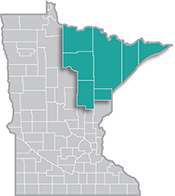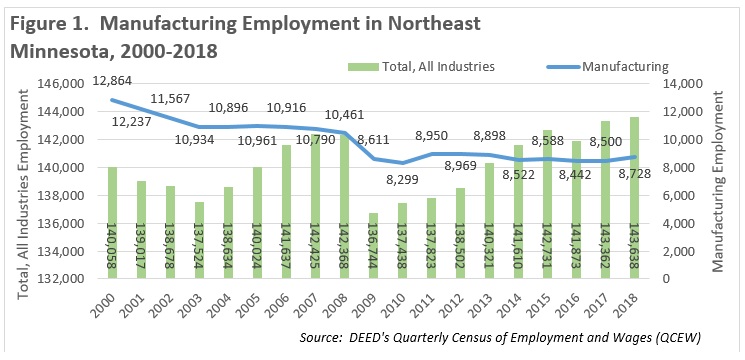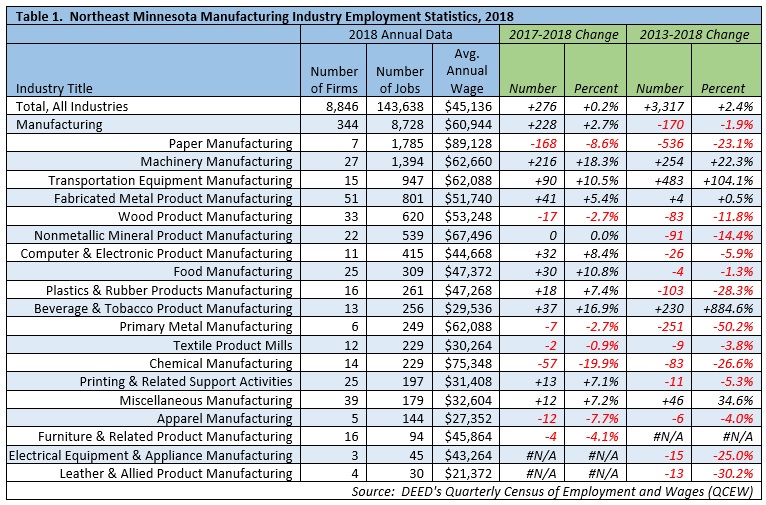 Home to the state's second-largest metro, the Northeast Region has a strong industrial sector, tied largely to the area's abundant natural resources.
Home to the state's second-largest metro, the Northeast Region has a strong industrial sector, tied largely to the area's abundant natural resources.
Most of the manufacturing base centers on mining and forest products industries. More than half of the sector's employment is in paper and machinery manufacturing.
Want the freshest data delivered by email? Subscribe to our regional newsletters.
9/10/2019 1:30:00 AM
Erik White
With 8,728 employees at 344 establishments, manufacturing is the sixth largest employing industry in the seven-county Northeast Minnesota planning region. As such, the Arrowhead has the lowest concentration of manufacturing employment of the six planning regions in the state, with only 6.1 percent of total jobs in manufacturing compared to 11.2 percent statewide.
Regional manufacturers enjoyed a slight increase in jobs over the past year, but the long-term trend has been a decrease of employment. There were 12,864 manufacturing jobs in the Arrowhead at the start of the century, with employment bottoming out at 8,299 jobs in 2010 at the height of the Great Recession, a 35.5 percent reduction. However, the industry rebounded with an increase of 670 new jobs from 2010 to 2012 and has mostly held firm since then. Total employment also suffered declines during the recession but has rebounded and regained all jobs that were lost (Figure 1).

With 1,785 employees, paper manufacturing is still the largest manufacturing subsector in the region. However, this subsector has been hit hard with layoffs occurring at various paper plants in the area over the past five years, resulting in a loss of 536 jobs – nearly one-quarter of all paper manufacturing employment.
 In contrast, machinery manufacturing now has 1,394 employees at 27 firms in Northeast Minnesota after increasing employment by 216 jobs in the last year. The transportation equipment manufacturing subsector has also seen significant employment gains, adding nearly 100 jobs in the last year and 483 new jobs in the past five years, doubling its employment in that time frame. The beverage and tobacco product manufacturing industry is the fastest growing manufacturing subsector. The subsector gained 230 jobs in the past five years, a nearly nine-fold increase to employment (Table 1).
In contrast, machinery manufacturing now has 1,394 employees at 27 firms in Northeast Minnesota after increasing employment by 216 jobs in the last year. The transportation equipment manufacturing subsector has also seen significant employment gains, adding nearly 100 jobs in the last year and 483 new jobs in the past five years, doubling its employment in that time frame. The beverage and tobacco product manufacturing industry is the fastest growing manufacturing subsector. The subsector gained 230 jobs in the past five years, a nearly nine-fold increase to employment (Table 1).
In addition to jobs, another important aspect of the manufacturing industry is that it has a bigger paycheck than the average job in the region. Manufacturers provided more than $530 million in total payroll in 2018, which was the fourth largest industry overall. According to DEED’s Quarterly Census of Employment and Wages (QCEW) data tool, the average annual wage for a manufacturing job was $60,944 – more than $15,800 higher than the average annual wage across all industries in the region. Paper manufacturing has the highest wages with an average annual wage of $89,128, nearly twice as much as the average wage in the region (Table 1).

Contact Erik White at 218-302-8413.